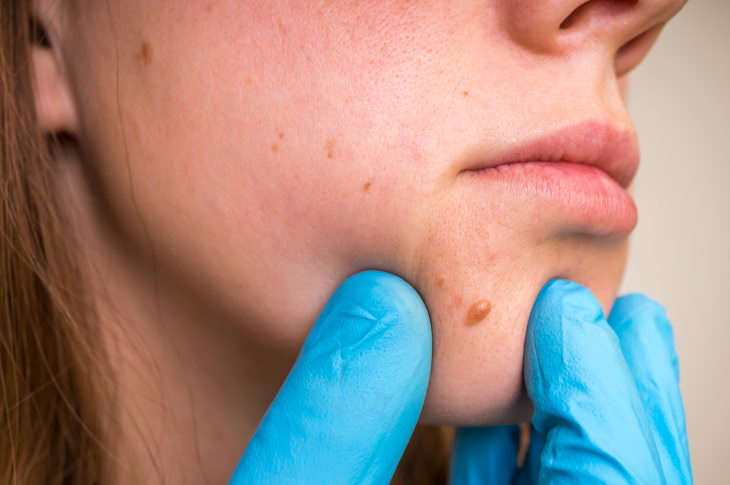
Skin tags can appear unsightly and be quite annoying. When accidentally snagged by jewelry or clothing, they can be quite painful and tend to bleed a lot. This could make you wonder - is there a way to remove them? And if so, is it even safe to do so?
Also known as acrochordons, skin tags are not-cancerous skin growths that consist of collagen fibers embedded in skin and fat cells. Nearly half of all people have skin tags, so it’s a very common condition. In most cases, skin tags appear in the skin folds or in areas where clothing is continually rubbing against the skin, such as the armpits, neck, breasts, eyelids, and groin area.
In this article, we review the available skin tag removal methods - both home treatments and in-office procedures. We also explain how to detect a skin tag and in which cases you ought to remove a skin tag.
When they first appear, skin tags look like a flat pinhead spot. At this stage, most skin tags are the same color as your skin, and they often go unnoticed, unless they’re in a prominent area like your eyelids. Some skin tags remain as tiny as just 2 millimeters (0.078 in) in diameter, whereas others grow bigger, reaching the size of up to 5 cm (almost 2 in). Over time, skin tags can darken, become rougher to the touch, and hang off the skin on thin stalks.

It’s a good idea to ask a dermatologist or physician to examine a growth that you suspect to be a skin tag. This can be easily done during your annual physical checkup or mole screening. A dermatologist will be able to tell if your skin tag isn't a more serious type of finding like skin cancer.
Skin tags are not contagious and rarely cause pain or discomfort. Some skin tags simply rub off on their own or burst under their own pressure. However, you may want to remove a skin tag for cosmetic reasons or because they snag onto jewelry or clothing and bleed.
If you intend to remove a skin tag, you have a variety of options. At-home treatments can help dry out the skin tag until it shrinks and falls off, and there are several in-office treatments available too. We review them all right here.
There are a number of home remedies for skin tag removal. These treatments slowly dry out the skin tag, so it usually takes longer to see results. Avoid cutting off a skin tag yourself - it will bleed a lot and may become infected. Also, resist removing the skin tag on your own in any of the following cases:
- The skin tag is larger than a match head.
- It is located close to the eyes or around private parts.
- The growth is painful, bleeding, or itching.
Here’s a brief list of home remedies used for healing skin tags.

Tea tree oil is an essential oil made from the leaves of the Melaleuca alternifolia plant native to Australia where it has been used as traditional medicine for centuries. Tea tree oil is NOT made from the tea plant. Tea tree oil has both antiviral and antifungal properties, and it can be used to dry out skin tags, but you must dilute it in a base oil, such as jojoba oil, coconut oil, or olive oil, otherwise, it will irritate the skin.
How to use:
1. Mix 1 tablespoon of a base oil of your choice with 5 drops of tea tree oil.
2. Clean the affected area.
3. Dip a cotton swab in the oil mixture and gently massage the oil on the skin tag. There should be a light layer of oil left on the area.
4. Cover the area with a bandage and leave it overnight.
Repeat this process every night until the tag falls off on its own. This usually takes around 6 weeks of daily use, but you should see that the tag begins drying out after 2-3 weeks.

Apple cider vinegar is an acid, and acids like salicylic acid or glycolic acid are widely used in cosmetology and dermatology to exfoliate the skin. Note that apple cider vinegar is much stronger than skincare products formulated with acids, so you should avoid using it on large areas of the skin or leave it on the skin.
These strong exfoliating properties of apple cider vinegar are beneficial for targeted use when removing skin tags. In a couple of weeks, the skin tag will be gone. Best of all, you don’t need to leave the smelly apple cider vinegar on the skin overnight - just apply, leave for 15 minutes, rinse, and you’re done! For detailed instructions, go here - Apple Cider Vinegar Can Help You Lose Those Skin Tags.


Have some leftover banana peels? Believe it or not, you can use them to remove a skin tag. Enzymes and antioxidants that are naturally present in banana peels are capable of dissolving and shrinking skin tags. Using banana peels for skin tag removal is easy - just place a small piece of the peel over the tag and secure it with a clean bandage. Leave the banana peel on the skin tag overnight, and repeat this home treatment until the skin tag is gone.
There are other known home methods of skin tag removal, such as applying iodine, toothpaste, or liquid vitamin E to the area. However, there’s little evidence (both anecdotal and scientific) that they are truly effective.
If you decided to remove a skin tag at home, you don’t have to rely on home remedies alone. There are a number of over-the-counter (OTC) products available at drugstores that can help you safely remove a skin tag. We review the most common OTC remedies of skin tags below.
You can purchase at-home freezing kits that contain chemicals that chill the skin tag and eventually make it fall off. These kits are effective, but they don’t lower the temperature of the skin tag as much as in-office treatments, so you may require to use them several times to remove a skin tag.
According to dermatologists, skin tags require temperatures as low as −4° to −58°F (−20 to −50°C) to be destroyed. This is why you should seek out the home freezing kit with the lowest temperature.
In addition, make sure to protect the surrounding area with a thick moisturizer or vaseline before applying the freezing kit. Otherwise, these home kits can irritate surrounding tissues.

Removal patches contain medications and adhere to the skin. You simply stick it on the skin tag for several days or weeks, and then the skin tag is supposed to come off. Dermatologists point out, however, that these patches may contain many skin-irritating ingredients and may not be effective because they’re not regulated by the Food and Drug Administration (FDA).
As for skin tag removal creams, these are pretty straightforward. They work by exfoliating and dissolving the skin tag after 2-3 weeks of daily application. It’s best to apply these creams on a clean and dry area for better adherence and wait for the skin to fully absorb the cream before putting on any clothing. Avoid applying these creams to large skin areas, as they can cause irritation and contact dermatitis in some people.
A dermatologist can remove a skin tag professionally. The advantages of in-office skin tag removal are a much lower risk of scarring, bleeding, and infection. A doctor may also send the skin tag for additional testing to make sure that it’s benign. However, professional removal may cost more and requires scheduling and traveling to the doctor, so it may not be available to everyone. At the doctor’s office, a professional may use any of the following methods to remove a skin tag:
- Cryosurgery. This quick procedure involves freezing the skin tag with liquid nitrogen. A skin tag will turn black and fall off on its own after 10 days. A temporary mark or discoloration may appear at first, but it usually goes away with time.

- Excision. Your doctor may choose to remove a skin tag with a sterile scalpel or scissors, sometimes with local anesthesia. Usually, only small tags are removed like this, and the doctor will apply a treatment to stop the bleeding. Note that the blade used in this surgery is much sharper than your home scissors or razors, and the procedure is completed in sterile conditions, so it has a much lower risk of scarring and infection.
- Ligation. This is when the tag is tied off at the base to sever the blood supply and make it die off on its own. This only works for small skin tags that have a very narrow base, and it is better to do it professionally.
- Cauterization. This method uses an electrical needle or probe that burns off the skin tag at its base. The high heat instantly seals the wound too, preventing bleeding or infection.
Lastly, please note that skin tags located around the eye area or the eyelids may require an eye doctor to be removed. This is because the skin around the eye area is very fragile, and so there is a risk of eye injury.
We hope that this article answered all of your questions. If so, consider sharing it with those who may find it interesting or useful as well.